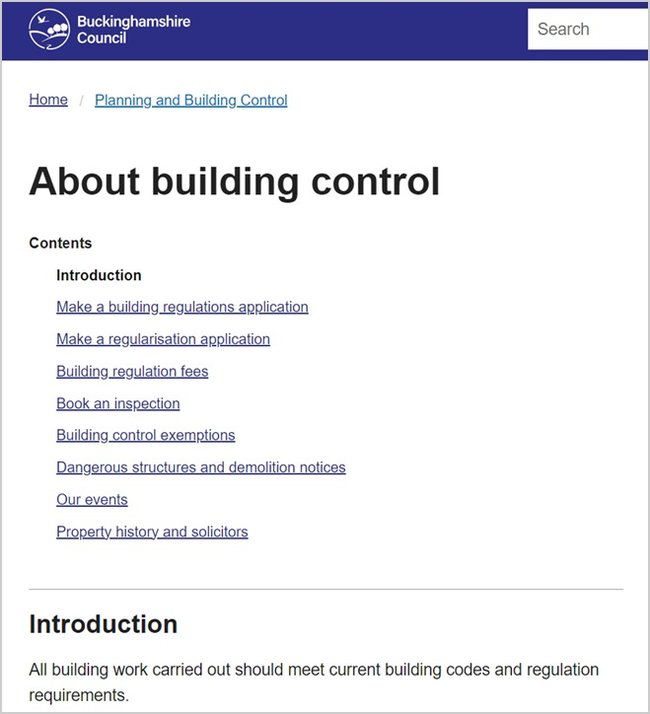Taking control of our building regulations content

How we used research and design to review our Building Control content.
We were contacted by our building control team to help review their web pages to make it easier for developers, builders, and residents to find information and make applications.
As the team offers services that residents can also get through private companies, they wanted to make sure that they were offering a competitive equivalent.
What we had
Our content was based on our ‘Inline index’ web template.
This meant that all the tasks associated with building control where on a single set of pages that users click through.

Example of our old design for building control
As a digital team, we have found through feedback that this template is the one that confuses people the most. We think this is because users can carry out tasks and select ‘Next page’ and are sometimes unsure which of these 2 processes they should be following.
How we went about reviewing it
Looked at what we have
We tackled the problem by reviewing the existing content.
This helped us to understand:
- what pages were on our site
- what tasks or services users should be able to complete
- where page content or page titles could be improved
- which pages were the most popular based on our analytics
Spoke to the team
We spoke to the team to get a better understanding of what their customer queries were and what they were looking to achieve with the review.
They needed to make their offering more accessible. Allowing users to find the information they needed quickly, without hunting around.
Asked users of the services
We carried out some user research with users of the services. This was split between:
- building professionals
- residents with no prior building knowledge
We did online tests which helped us to understand what content they were looking for and the priority of this information.
Looked at what other councils had done
One thing that’s great about writing local authority content is that there is lots of resources out there in terms of other council websites.
For example, we really like the building control content on Bristol.gov.uk.
What we learnt
We knew we needed to make it easier for service users to find the tasks they needed to use. This meant changing the way they were displayed and understanding what needs needed to be met by the content.
Our user research helped us identify what was important to both sets of users and where there was an overlap between these things. This included making sure there was an easy and obvious way to:
- contact the team
- complete things online
- view the application fees
Often building professionals do not have the luxury of sitting by a computer to complete these tasks so our revisions needed to support working quickly and from a mobile device.
Prototyping
We reviewed the pages we had alongside our user research and used this to identify tasks that needed their own page.
We knew that by doing this it would help surface the tasks better from search and give users the reassurance that they were on the correct page.

Example of our working in Miro.

Example of one of our new task-based content pages.
Working with the planning digital team
Alongside reviewing the pages and how they were structured, we were working with our planning digital team.
They are using a new digital service called ‘Plan X’ to design and build a new set of digital forms for the building control services to replace their existing forms.
We worked together to make sure that the language of the content and how we named the services that users could complete was consistent between web page and form.

Example of a plan X form.
The Plan X service is being developed in partnership with other councils and the Department for Levelling Up, Housing and Communities (DLUHC).
Codesign is the best design
This process was not done by one person alone.
We:
- collaborated as a digital team by peer reviewing the new pages
- led the Building Control team through the process by planning the next stage and keeping them informed along the way
- got feedback from professionals and residents about what was important
- worked closely with the planning digital team to ensure the journey from page to form was as seamless as possible
Publishing our new content
We recently published our new look building control content.

Example of our revised content.
The improvements we have made include:
- creating a dedicated landing page for building control
- simplifying the language and structure of the content, making it easier to understand and follow
- adding clear and consistent calls to action, such as 'apply' and 'contact us'
- providing more information and guidance on the different types of building control applications and inspections
- using interactive elements, such as accordions, to display relevant content without cluttering the page
- incorporating the planning digital team’s new digital application forms
What’s happened since we went live
Since going live with the new pages and forms, the Building Control team received feedback about the digital inspection form.
The form was quickly updated, stripping out what we could to make the journey simpler and to address a problem that builders faced where they did not know the exact postcode so were unable to proceed.
Testing, testing, testing
Publishing something and hoping that users will tell you if it does not work can mean we miss an opportunity to improve.
We’re now organising some usability testing sessions to see if there are further things we can iterate on. These sessions will be moderated tests and we’ll ask users of the service to complete tasks on desktop and mobile devices to understand if further iterations could help.